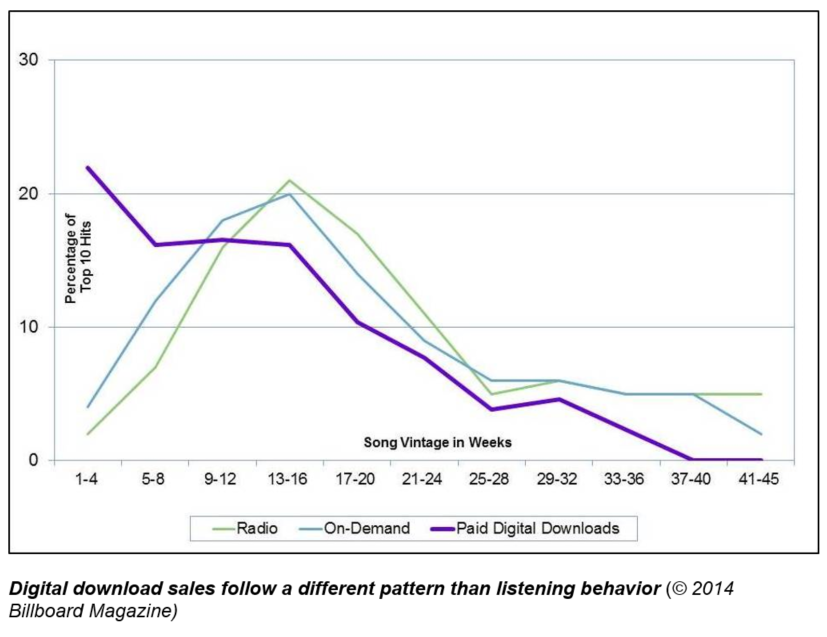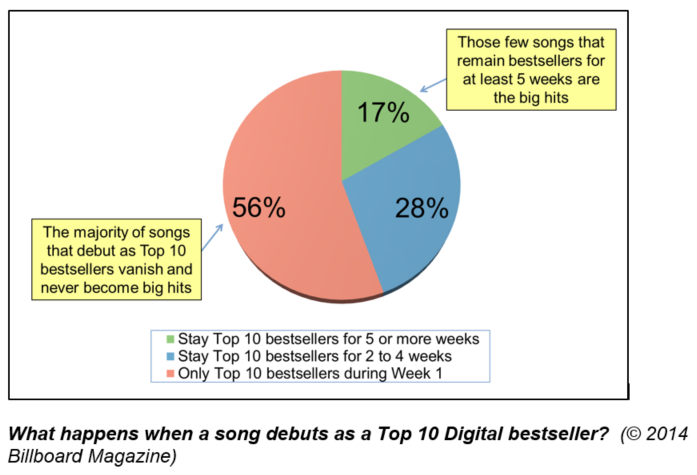Our recent blog series explained why radio should still look at sales data alongside streaming data to help pick the right new music. We noted that buying music isn’t the same as listening to music, a difference we examined in detail in 2015 when Integr8 was a part of Coleman Insights. Here’s a recap of that analysis:
Music buying and music listening patterns are fundamentally different. When you understand why they’re different, you’ll also understand how making new music decisions based on sales data could lead your station astray.
We analyzed 26 consecutive weeks of the Billboard® Top 10 Digital Songs chart, which ranks the biggest paid digital download singles in online stores such as iTunes, as well as Billboard’s Top 10 songs for Radio exposure and On-Demand streaming during the same period, to understand how listeners consume new music from each source.
While the majority of songs listeners hear most on the radio and play most on on-demand streaming services are between 9 and 20 weeks old, the majority of songs listeners buy most are 12 weeks old or less.
Why are buying and listening patterns so different?
Just because people stop buying a song doesn’t mean people stop playing it. Think about your own music collection. You probably own some songs that you forgot about almost as soon as you got them, as well as songs you’ve listened to regularly for years. When a song’s sales decline, it means fewer new people want to buy it—it doesn’t mean the people who already bought it stopped playing it.
If you exposed new music on your radio station solely based on how well a song was selling, you’d play songs most frequently when a lot of your listeners still don’t know the song. Even those listeners who have heard it once or twice haven’t heard it enough times to warm up to it yet. That’s why songs that have already become bestsellers often score poorly during their first week in your callout research.
If you stopped playing a song as soon as its sales started slipping, you’d likely be dropping the song at the moment your audience was most interested in hearing it. After all, the people who already bought the song may well still be playing it a lot, too.
Furthermore, unlike radio exposure and on-demand streaming behavior, song sales in the CHR universe do not build over time. In fact, over half of all songs that will ever become Top 10 bestselling digital downloads debut as Top 10 bestsellers in their first week on the charts. (Country follows a different pattern, as we explored in Why Country Isn’t CHR.)
Since the best-selling songs are significantly newer than the biggest songs on the radio and the songs listeners play most on on-demand services, you might assume you could use today’s song sales to predict tomorrow’s hits on your radio station. However, our analysis also shows only one in six songs that debut as Top 10 bestsellers go on to become big hits on radio or on-demand.
What separates the hits from the stiffs? The hits don’t merely debut as top 10 bestsellers; the hits stay top 10 bestsellers for at least five weeks.
Ariana Grande & Big Sean’s “Best Mistake”, Shawn Mendes’ “Life of the Party” and four different tracks from 5 Seconds of Summer all debuted as Top 10 digital bestsellers, but these songs were among the 56% that were only Top 10 bestsellers during their debut week. Die-hard fans may have eagerly purchased these artists’ latest releases, but few others wanted to buy or hear them thereafter.
During the same time, Ariana Grande & Iggy Azalea’s “Problem”, Ariana Grande & Zedd’s “Break Free” and Maroon 5’s “Maps” were among the 17% of songs that debuted as Top 10 bestsellers and remained Top 10 bestsellers for at least five weeks. These songs were also among 2014’s biggest Top 10 hits on radio and on-demand.
In fact, the biggest hits of 2014, including MAGIC!’s “Rude”, Iggy Azalea’s “Fancy” and John Legend’s “All Of Me” are notable not because of how strong they debuted, but how well they kept selling week after week. While most songs are no longer Top 10 bestsellers after 12 weeks, these #1 smashes are among those rare songs that remained Top 10 bestsellers for 17 to 36 weeks.
Undoubtedly, many of the people who bought these songs on iTunes week after week did so because they loved hearing them on your radio station.
Bottom line: Don’t look at what songs are selling well this week. Look for songs that keep selling week after week.
Integr8 New Music Research helps you pick the right new music for the listeners that matter most to your ratings.


